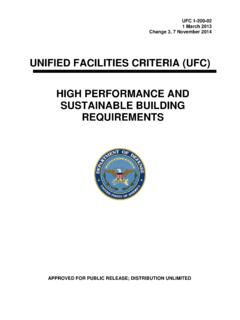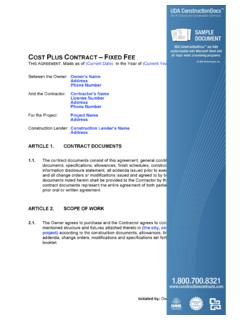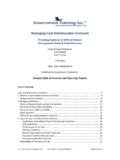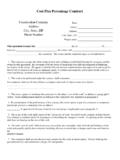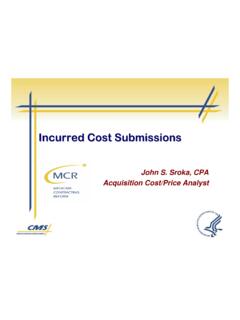Transcription of Ch 1 - Establishing And Monitoring Contract Type
1 Ch 1 - Establishing And Monitoring Contract Type - Chapter Introduction - Matching Contract Type to Contract Risk - Utilizing fixed -Price Economic Price Adjustment Contracts o - Establishing Terms And Conditions For Economic Price Adjustment o - Making an Economic Price Adjustment Using Cost Indexes - Structuring And Applying Incentive Pricing Arrangements o - Structuring A Cost Incentive Pricing Arrangement o - Applying a Cost Incentive Pricing Arrangement - Structuring and Applying Award-Fee Pricing Arrangements o - Structuring an Award-Fee Pricing Arrangement o - Applying an Award-Fee Pricing Arrangement - Structuring a fixed -Price Redeterminable Pricing Arrangement Appendix 1A - Performance Evaluation Criteria Appendix 1B - Contractor Performance Evaluation Report Chapter Introduction When used in this chapter, the terms " Contract type" and "type of Contract " refer to the Contract compensation arrangement.
2 The Contract compensation arrangement is the method of determining the dollars due to the contractor under the Contract . In this chapter, you will learn about the development and application of common compensation arrangements: Matching Contract Type To Contract Risk Points to Consider (FAR ). Contract type selection is the principal method of allocating cost risk between the Government and the contractor. There is no single Contract type that is right for every contracting situation. Selection must be made on a case-by-case basis considering Contract risk, incentives for contractor performance, and other factors such as the adequacy of the contractor's accounting system. Your objective should be to select a Contract type that will result in reasonable contractor risk with the greatest incentive for efficient and economical Contract performance. Selecting the proper Contract type will make the work more attractive to more potential offerors, thereby increasing competition.
3 As you match Contract type to Contract risk, consider the following: Identify available Contract types ; Consider acquisition method; Consider commerciality of the requirement; Consider cost risk associated with the Contract action; Consider appropriate performance incentives; Consider the accounting system adequacy; and Document the selection decision. Identify Available Contract types . The table on the following pages compares the most common compensation arrangements. Most of those arrangements fit into two general categories fixed -price and cost-reimbursement, but labor-hour and time-and-materials contracts have characteristics of both: fixed -Price (FAR Subpart ). Under a fixed -price Contract , the contractor agrees to deliver the product or service required at a price not in excess of the agreed-to maximum. fixed -price contracts should be used when the Contract risk is relatively low, or defined within acceptable limits, and the contractor and the Government can reasonably agree on a maximum price.
4 Contract types in this category include: o Firm fixed -price (FFP) o fixed -price economic price adjustment (FPEPA) o fixed -price award-fee (FPAF) o fixed -price incentive firm (FPIF) o fixed -price incentive with successive targets (FPIS) o fixed -price Contract with prospective price redetermination (FPRP) o fixed -ceiling-price Contract with retroactive price redetermination (FPRR) o Firm fixed -price level of effort term Contract (FFPLOE) Cost-Reimbursement (FAR Subpart ). Under a cost-reimbursement Contract , the contractor agrees to provide its best effort to complete the required Contract effort. Cost-reimbursement contracts provide for payment of allowable incurred costs, to the extent prescribed in the Contract . These contracts include an estimate of total cost for the purpose of obligating funds and Establishing a ceiling that the contractor cannot exceed (except at its own risk) without the approval of the contracting officer.
5 Contract types in this category include: o Cost (CR) o Cost-sharing (CS) o Cost-plus- fixed -fee (CPFF) o Cost-plus-award-fee (CPAF) o Cost-plus-incentive-fee (CPIF) Labor-Hour and Time-and-Materials (FAR Subpart ). There are two other types of compensation arrangements that do not completely fit the mold of either fixed -price or cost-reimbursement contracts. Labor-hour and time-and-materials contracts both include fixed labor rates but only estimates of the hours required to complete the Contract . They are generally considered to most resemble cost-reimbursement contracts because they: o Do not require the contractor to complete the required Contract effort within an agreed-to maximum price; and o Pay the contractor for actual hours worked,. Comparison of Major Contract types Firm fixed -Price (FFP) fixed -Price Economic Price Adjustment (FPEPA) fixed -Price Incentive Firm (FPIF) fixed -Price Award-fee (FPAF) fixed -Price Prospective Redetermination (FPRP) Principal Risk to be Mitigated None.
6 Thus, the contractor assumes all cost risk. Unstable market prices for labor or material over the life of the Contract . Moderately uncertain Contract labor or material requirements. Risk that the user will not be fully satisfied because of judgmental acceptance criteria. Costs of performance after the first year because they cannot be estimated with confidence. Use The requirement is The market prices at risk are severable A ceiling price can be established Judgmental standards can be fairly The Government needs a firm commitment from well-defined. Contractors are experienced in meeting it. Market conditions are stable. Financial risks are otherwise insignificant. and significant. The risk stems from industry-wide contingencies beyond the contractor's control. The dollars at risk outweigh the administrative burdens of an FPEPA. that covers the most probable risks inherent in the nature of the work.
7 The proposed profit sharing formula would motivate the contractor to control costs to and meet other objectives. applied by an Award-fee panel. The potential fee is large enough to both: Provide a meaningful incentive. Justify related administrative burdens. the contractor to deliver the supplies or services during subsequent years. The dollars at risk outweigh the administrative burdens of an FPRP. Elements A firm fixed -price for each line item or one or more groupings of line items. A fixed -price, ceiling on upward adjustment, and a formula for adjusting the price up or down based on: Established prices. Actual labor or material costs. Labor or material indices. A ceiling price Target cost Target profit Delivery, quality, and/or other performance targets (optional) Profit sharing formula A firm fixed -price. Standards for evaluating performance. Procedures for calculating a fee based on performance against the standards fixed -price for the first period.
8 Proposed subsequent periods (at least 12 months apart). Timetable for pricing the next period(s). Contractor is Obliged to: Provide an acceptable deliverable at the time, place and price specified in the Contract . Provide an acceptable deliverable at the time and place specified in the Contract at the adjusted price. Provide an acceptable deliverable at the time and place specified in the Contract at or below the ceiling price. Perform at the time, place, and the price fixed in the Contract . Provide acceptable deliverables at the time and place specified in the Contract at the price established for each period. Contractor Incentive (other than maximizing goodwill) 1 Generally realizes an additional dollar of profit for every dollar that costs are Generally realizes an additional dollar of profit for every dollar that costs are Realizes a higher profit by completing the work below the ceiling Generally realizes an additional dollar of profit for every dollar that costs For the period of performance, realizes an additional dollar of profit for every dollar reduced.
9 Reduced. price and/or by meeting objective performance targets. are reduced; earns an additional fee for satisfying the performance standards. that costs are reduced. Typical Application Commercial supplies and services. Long-term contracts for commercial supplies during a period of high inflation Production of a major system based on a prototype Performance-based service contracts. Long-term production of spare parts for a major Limitations in FAR Parts 16, 32, 35, and 52 Generally NOT appropriate for R&D. Must be justified. Must be justified. Must be negotiated. Contractor must have an adequate accounting system. Cost data must support targets. Must be negotiated. MUST be negotiated. Contractor must have an adequate accounting system that supports the pricing periods. Prompt redeterminations. Variants Firm fixed -price Level of Effort. Successive Targets Retroactive Redetermination1 Goodwill is the value of the name, reputation, location, and intangible assets of the firm.
10 Comparison of Major Contract types Cost-Plus Incentive-Fee (CPIF) Cost-Plus Award-Fee (CPAF) Cost-Plus fixed -Fee (CPFF) Cost or Cost- Sharing (C or CS) Time & Materials (T&M) Principal Risk to be Mitigated Highly uncertain and speculative labor hours, labor mix, and/or material requirements (and other things) necessary to perform the Contract . The Government assumes the risks inherent in the Contract -benefiting if the actual cost is lower than the expected cost-losing if the work cannot be completed within the expected cost of performance. Use An objective relationship can be established between the fee and such measures of Objective incentive targets are not feasible for critical aspects of performance. Relating fee to performance ( , to actual costs) would be The contractor expects substantial compensating benefits for absorbing No other type of Contract is suitable ( , because costs are performance as actual costs, delivery dates, performance benchmarks, and the like.)


